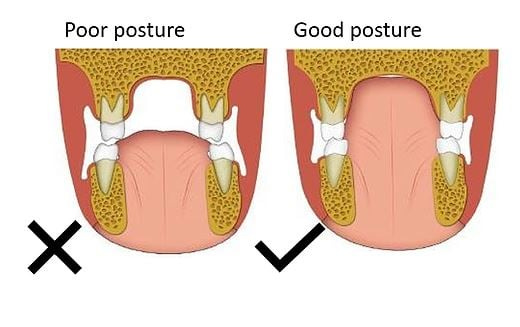The Importance of Tongue Posture for Overall Health

Annette Verpillot has some remarkable insights into tongue posture and Its multifaceted benefits
Much like how we conscientiously maintain proper sitting and standing posture for the well-being of our necks and backs, Annette’s research sheds light on the significance of cultivating good tongue posture for our oral health.
She argues that the tongue is a powerful muscle that impacts many parts of the body beyond the mouth, including our ability to breathe, sleep, look, and feel. Her research that shows that people with improper tongue positioning are more likely to have sleep apnea, snoring, headaches, and TMJ (temporomandibular joint disorder).
Proper tongue positioning, also known as tongue posture, is important for oral health and overall well-being[1][2][3][4][5][6]. When at rest, the tongue should gently rest on the roof of the mouth and away from the teeth[1][2][5][6]. This helps to promote proper alignment of the teeth and jaw, and can prevent problems such as jaw and neck pain, shifting teeth, breathing difficulties, and more[4].
Improper tongue posture can contribute or lead to bite dysfunction, which is known to cause headaches, migraines, and facial pain[3]. It can also affect other areas of the body, including the eyes, nose, head, neck, and shoulders[1].

The positioning of the tongue holds sway over various facets of our physiological state, including nasal breathing, sinus health, ocular comfort, cranial alignment, neck condition, and shoulder well-being. Thus, it becomes imperative to grasp the correct way to maintain tongue posture.
Let's first address the erroneous approach that many inadvertently adopt: a tongue that resides at the lower recesses of the mouth, exerting pressure against the lower teeth. Have you recognized this in your own posture? If so, it's indicative of improper tongue alignment.
Proper tongue posture involves the tongue gently resting at the upper palate, situated behind the front teeth. The entirety of the tongue, including its rear portion, should make contact with the roof of the mouth, akin to the circles depicted in the accompanying illustration. Meanwhile, lips should be sealed, and the teeth ought to rest slightly apart. Notably, there should be no undue pressure exerted on the front teeth, whether top or bottom, as even the most subtle force over time can induce their movement—a phenomenon harnessed by orthodontic practices.

The rewards of adopting the correct tongue posture are indeed multifarious:
- Enhanced Breathing
- Improved Sleep
- Enhanced Aesthetics
- Heightened Sense of Well-Being
To help cultivate the desired tongue posture, consider the following exercise:
- Position the tip of your tongue against the firm palate, situated on the roof of your mouth just above the upper teeth.
- Through gentle suction, draw the remainder of your tongue to rest flush against the roof of your mouth.
- Allow your mouth to gently close.
- Maintain this posture while breathing naturally, if possible.
In essence, the meticulous practice of optimal tongue posture can unlock an array of physiological benefits, contributing to improved overall health and well-being.
Annette is the founder of Posturepro, a health company specialized in restoring the brain-body connection. https://posturepro.co
Thank you for reading this post! If you found it helpful or informative, please consider sharing a 7 day free trial with your friends, family, or colleagues who might benefit from it.
Your support helps me reach more people and spread awareness on important topics like this. Together, we can make a difference!
Sources:
- [1] https://www.ismileva.com/proper-resting-tongue-position-yes-thats-a-thing/
- [2] https://www.colgate.com/en-us/oral-health/threats-to-dental-health/what-is-proper-tongue-posture-and-why-does-it-matter
- [3] https://www.ericdavisdental.com/faqs-and-blog/blog/tongue-posture-what-is-proper-tongue-posture-and-why-is-it-so-important/
- [4] https://www.enclavedental.com/blog/2021/09/22/holistic-dentist-southlake-discusses-proper-tongue-positioning/
- [5] https://www.healthline.com/health/tongue-posture
- [6] https://www.danvilledentalcare.com/tongue-posture-is-it-really-a-thing/




